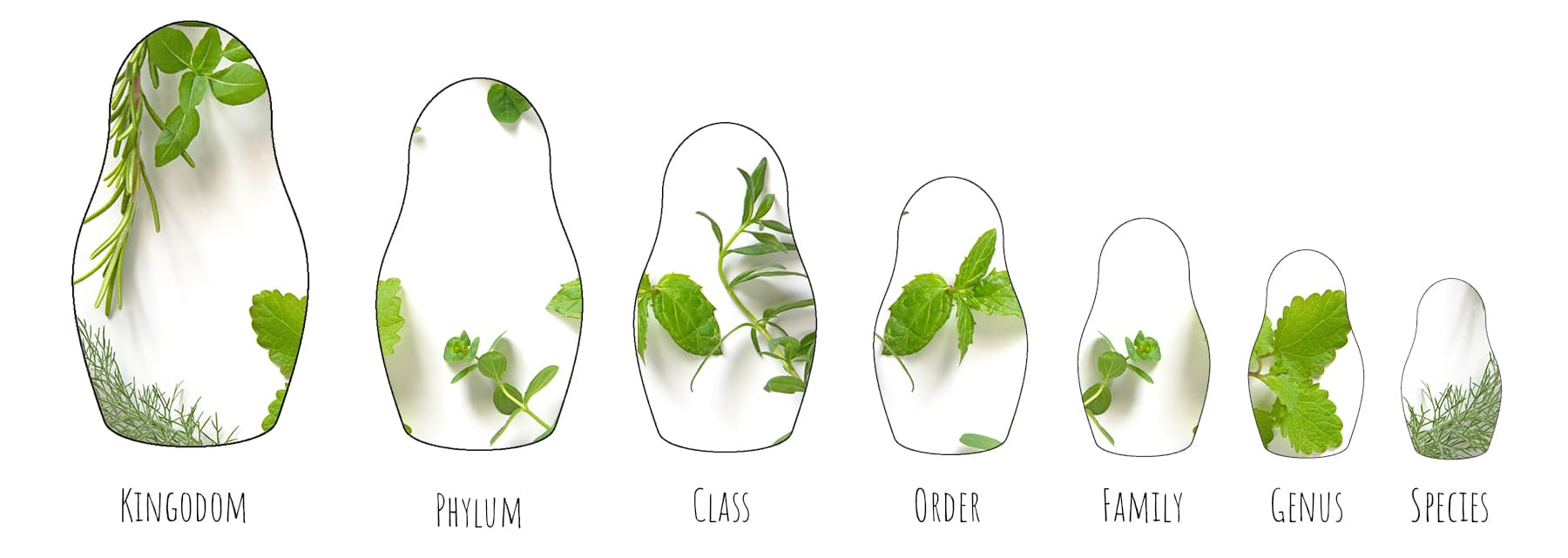Currently Empty: £0.00

Taxonomy: Back to Basics
When you learn gardening and plant knowledge by watching, seeking advise and just getting stuck in, the long Latin names of plants can be quite daunting. This bank-holiday weekend, we’re embracing the idea that it’s never too late to learn and going on a whistle stop tour of need-to-knows of taxonomy. I hope you’re comfortable, have a cuppa in hand and are ready to get back to basics. Happy reading!
Written by Ghislaine Howard
Taxonomy, simply put, is the science of biological classification. It’s the practice of putting natural things into groups so that we might make sense of how they relate to one another. The long Latin names we see written in italics next to more familiar names, are just the terms for some of those groups. This means that there are actual ‘secrets’ hidden in the Latin that we can use to help us understand more about the plant, if we only know what to look for.
The taxonomic system that we use today is based on one designed by Carl Linnaeus in the 1700s. Typically referenced are 7 hierarchical categories into which everything natural can be organised:

These categories can be compared to a set of Russian nesting dolls. Think of each category as a doll, sitting within another doll. As you move down the hierarchy (or take apart the dolls) the differences between things grouped into the categories get smaller/more refined (like the Russian dolls get smaller). Kingdom includes very general categories like plant and animal. Phylum gets a bit more specific, and class even more, order even more so and so on.
In the most part, if you’re a hobbyist herb grower you won’t be needing to worry about any of the categories that come before family (although the chances are you’ll already be able to recognise if something’s a plant or an animal). The categories that are very useful to know about are family, genus and species.
Why? Because when you see the Latin name of a plant, what you’re reading is the name of its genus group and it’s species. Lovage for example, which is Sara Dixon’s Herb of the Month for September (blog coming Wednesday 2nd), has the Latin name Levisticum officinale which tells us that it belongs to the genus Levisticum and to the species officinale.
It is useful to be aware of a plant’s family, genus and species because this can tell you how it might behave, and what conditions it needs to survive. The family won’t usually appear on the label (except perhaps in the description if there is one), but a quick online search and you’ll find it out – there’s no shame in doing this either. There are hundreds of plant families, more genera (plural of genus) and even more species, so don’t think that there is anyone who knows them all!
We use the Latin names, because (as Helen mentioned in Herb Histories: Elderberries) historically the common names for plants have varied across different regions and often the same name is used to refer to different plants – using the Latin names avoids total confusion. For these reasons alone, it is sage advice that you should never buy a plant if you don’t know it’s Latin name.
How else might the taxonomy help you? Hugely when it comes to designing your garden, allotment, or potted plants. This is for one vital reason: biodiversity. Growing a variety plants from different families is important in ensuring that your soil stays healthy. Too many similar plants will drain all the same resources from the soil without replenishing them. Plants from different families will require different resources, and, when they die, put back different resources into the soil. A variety of plants will also help to support a more varied ecosystem, encouraging in a more varied range of critters as well as helping to keep pests away.
If you’re considering using plants for their medicinal properties, it’s likely that you’ve already come across several named officinalis or officinale – like Levisticum officinale a.k.a lovage! That’s because the term officinalis comes from the word officina which in medieval Europe was the name of the building or room that we now recognise as their pharmacy (usually the storeroom of monasteries). Today we still use the term to reference plants that are recognised to have a long medicinal history.
Another useful, ‘hidden’ secret in Latin names is major. This one’s a little on the obvious size, I mean side; when a Genus has several species, sometimes one of the species will be called ‘major’ indicating that it is the largest of the species. Plantago major (a large plantain native to Europe, northern and Central Asia) is an example.
Latin names are packed full with meanings to decipher, similarly there’s also much more to taxonomy than this basics guide but don’t worry, we’ll have more on taxonomy over the coming weeks including how the system has changed over the years and more of the hidden secrets. If you’d like to get the next instalment delivered straight to your inbox then just email “Taxonomy please!” to blog@herbsociety.org.uk.



